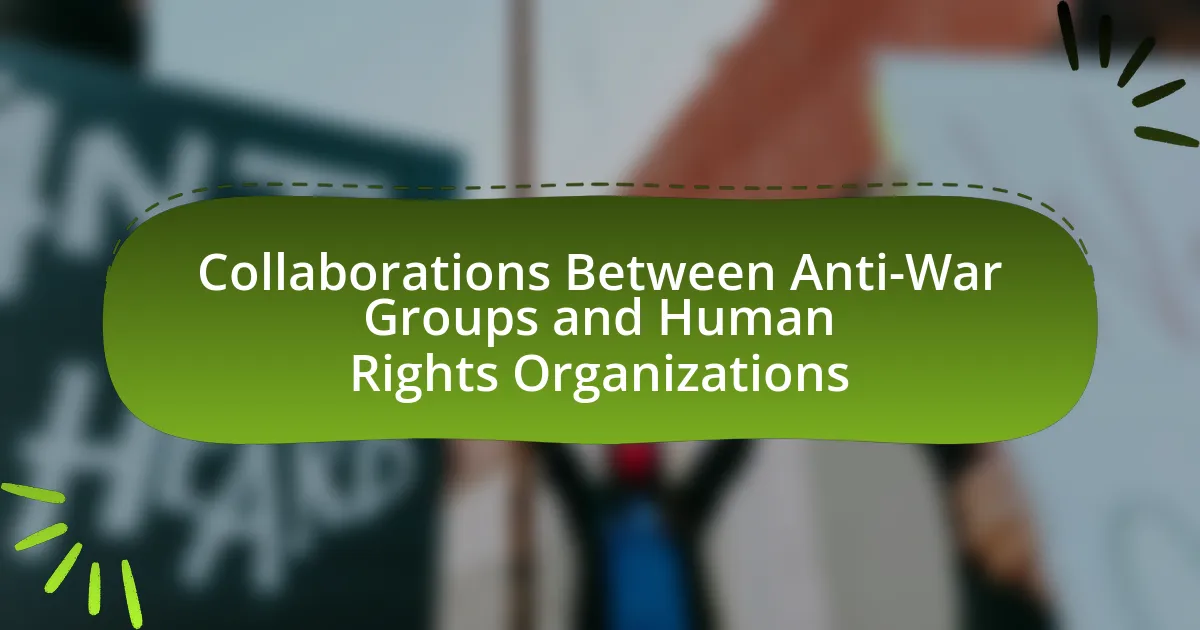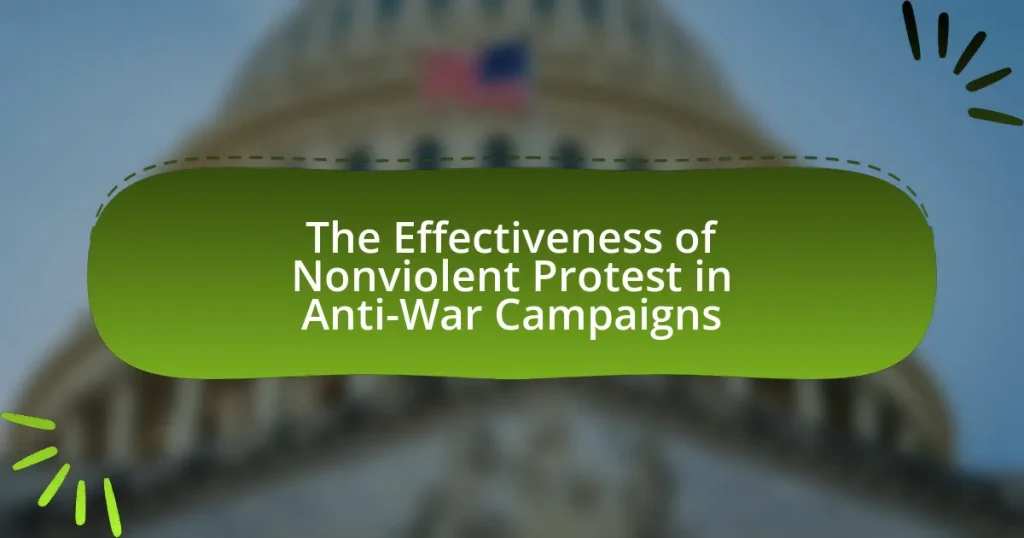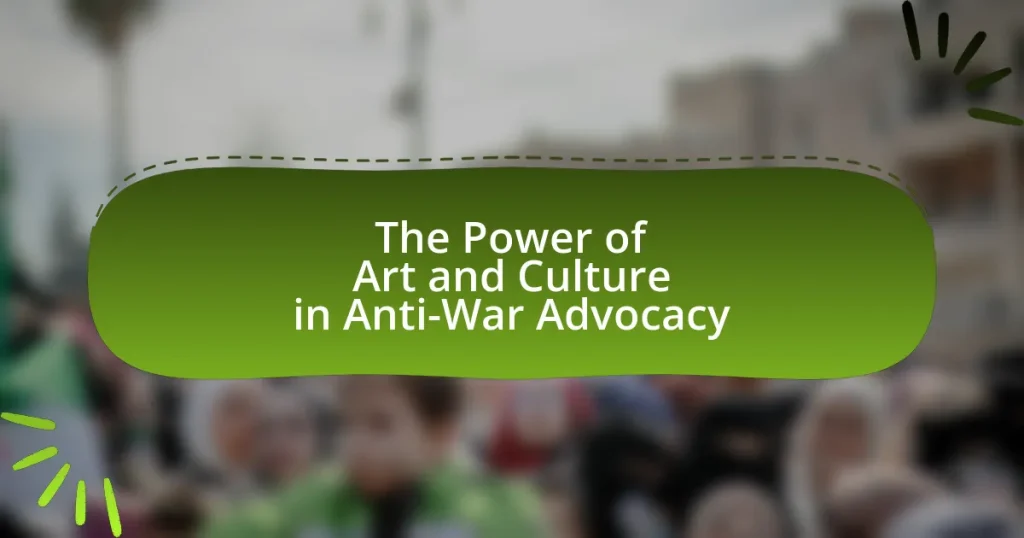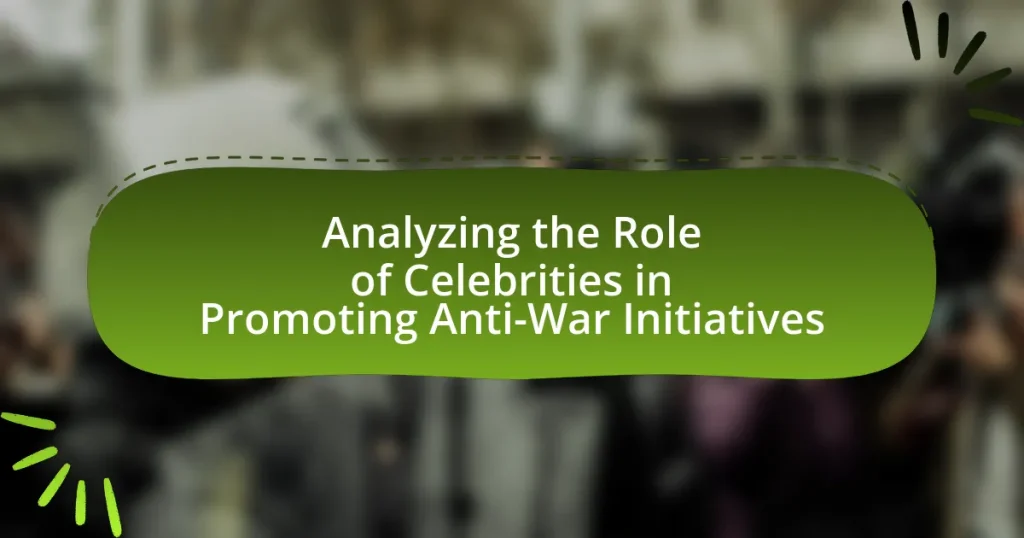Collaborations between anti-war groups and human rights organizations are joint efforts aimed at advocating for peace and protecting human rights in conflict zones. These partnerships focus on raising awareness about the humanitarian impacts of war, promoting disarmament, and influencing policy changes. Key players include organizations like Amnesty International and grassroots movements such as Code Pink, which work together on campaigns, advocacy initiatives, and public awareness efforts. Despite facing challenges such as differing priorities and funding constraints, these collaborations have proven effective in mobilizing public support and achieving significant policy changes, as evidenced by notable campaigns and joint initiatives.
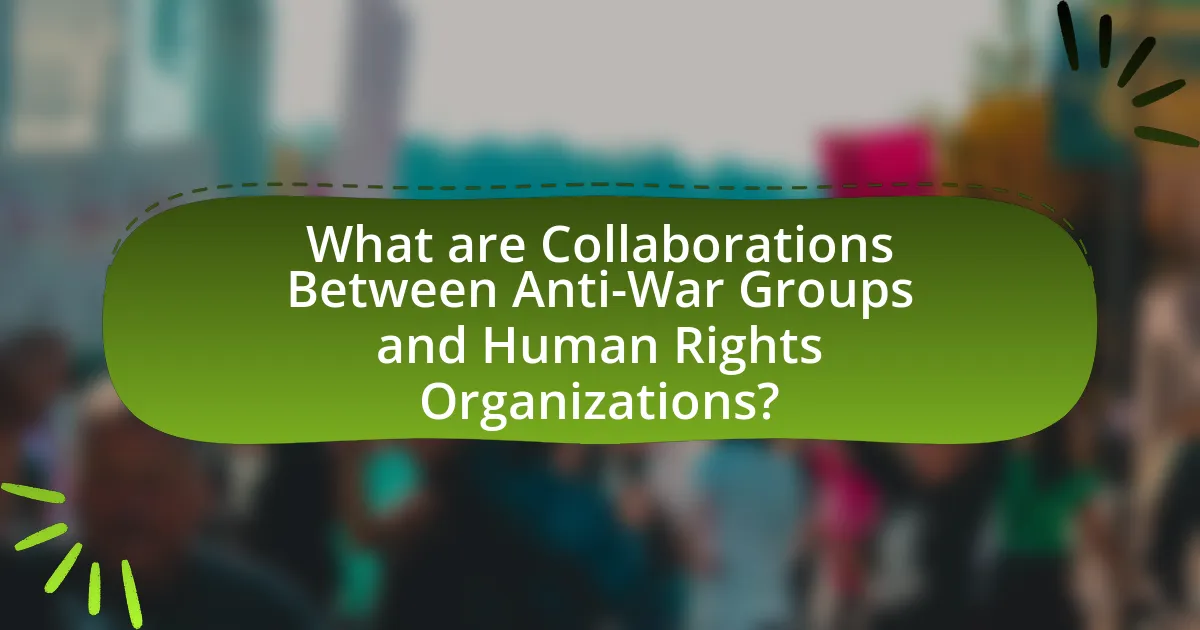
What are Collaborations Between Anti-War Groups and Human Rights Organizations?
Collaborations between anti-war groups and human rights organizations involve joint efforts to advocate for peace and protect human rights in conflict zones. These collaborations often focus on raising awareness about the humanitarian impacts of war, promoting disarmament, and holding governments accountable for violations of human rights during armed conflicts. For instance, organizations like Amnesty International and various anti-war coalitions have worked together to document war crimes and lobby for policy changes that prioritize human rights over military action. Such partnerships enhance the visibility of both movements, leveraging shared resources and networks to amplify their messages and influence public opinion.
How do these collaborations typically manifest?
Collaborations between anti-war groups and human rights organizations typically manifest through joint campaigns, advocacy initiatives, and shared resources aimed at promoting peace and protecting human rights. These collaborations often involve coordinated efforts to raise awareness about the humanitarian impacts of conflict, such as civilian casualties and displacement. For example, organizations may work together to produce reports, organize protests, or lobby governments for policy changes that align with their mutual goals. Evidence of such collaborations can be seen in events like the “Global Day of Action on Military Spending,” where various groups unite to challenge military expenditures and advocate for reallocating funds to social programs.
What types of activities do these collaborations involve?
Collaborations between anti-war groups and human rights organizations involve joint advocacy campaigns, public awareness initiatives, and policy lobbying efforts. These activities aim to raise awareness about the humanitarian impacts of war, promote peacebuilding efforts, and influence government policies regarding military interventions. For instance, organizations may collaborate on reports documenting human rights violations in conflict zones, organize protests or events to mobilize public support, and engage in legal actions to hold accountable those responsible for war crimes. Such collaborative efforts are essential for amplifying their voices and achieving shared objectives in promoting peace and protecting human rights.
Who are the key players in these collaborations?
The key players in collaborations between anti-war groups and human rights organizations include prominent organizations such as Amnesty International, Human Rights Watch, and the International Federation for Human Rights. These entities often partner with grassroots anti-war movements like Code Pink and Veterans for Peace to advocate for peace and human rights. Their collaborations typically focus on raising awareness about the humanitarian impacts of war, promoting disarmament, and influencing policy changes. For instance, Amnesty International has worked alongside anti-war groups to campaign against military interventions that violate human rights, demonstrating the effectiveness of their joint efforts in mobilizing public opinion and pressuring governments.
Why are these collaborations important?
Collaborations between anti-war groups and human rights organizations are important because they amplify advocacy efforts and enhance the effectiveness of campaigns against violence and injustice. By combining resources, expertise, and networks, these collaborations can address complex issues more comprehensively, leading to greater public awareness and policy change. For instance, joint initiatives can leverage the credibility of human rights organizations to highlight the humanitarian impacts of war, thereby mobilizing broader support for peace efforts. This synergy has been evidenced in various campaigns, such as the coalition efforts during the Iraq War, where coordinated actions led to significant public demonstrations and shifts in public opinion against military intervention.
What impact do they have on public awareness?
Collaborations between anti-war groups and human rights organizations significantly enhance public awareness of social justice issues and the consequences of conflict. These partnerships leverage combined resources and networks to disseminate information more effectively, reaching broader audiences through campaigns, reports, and events. For instance, joint initiatives often result in increased media coverage, which amplifies the visibility of human rights violations and the humanitarian impact of war, as evidenced by the heightened public discourse surrounding conflicts like the Syrian civil war, where organizations like Amnesty International and various anti-war coalitions have worked together to inform the public. This collaborative approach not only educates the public but also mobilizes grassroots activism, fostering a more informed citizenry that can advocate for policy changes.
How do they influence policy changes?
Anti-war groups and human rights organizations influence policy changes through advocacy, public campaigns, and coalition-building. These entities mobilize public opinion by raising awareness about the humanitarian impacts of war, which can pressure policymakers to reconsider military actions or adopt more peaceful resolutions. For instance, the collaboration between organizations like Amnesty International and various anti-war coalitions has historically led to significant shifts in government policies, such as the reduction of military funding or the implementation of diplomatic negotiations instead of armed conflict. Their combined efforts often result in increased media coverage and public discourse, which further amplifies their impact on legislative processes.
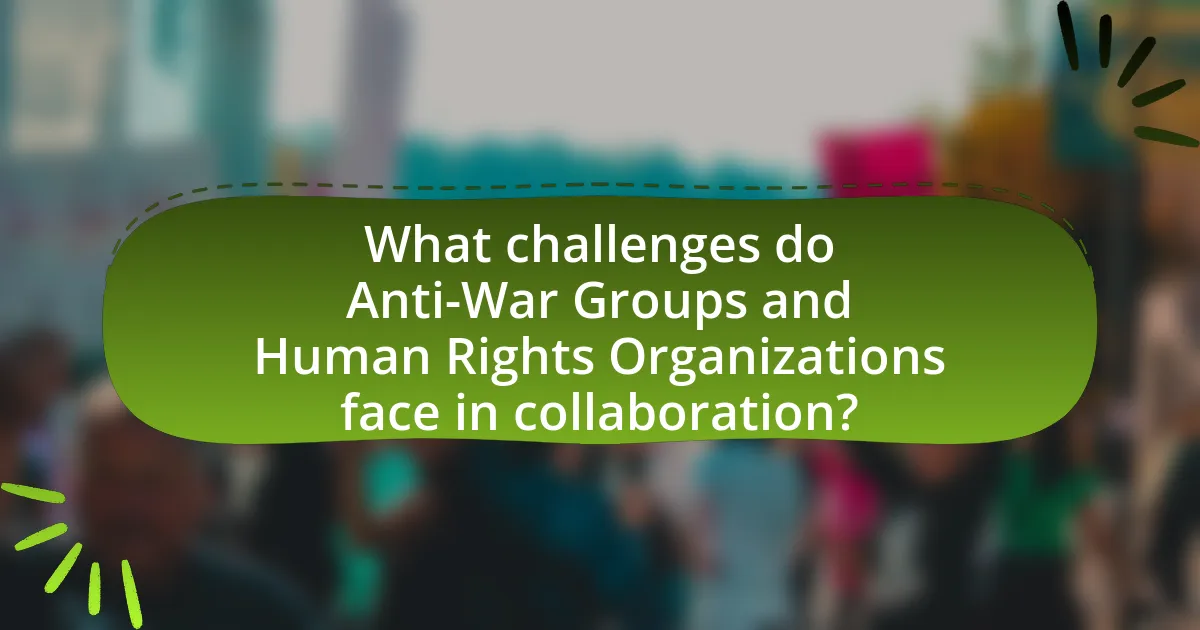
What challenges do Anti-War Groups and Human Rights Organizations face in collaboration?
Anti-war groups and human rights organizations face significant challenges in collaboration, primarily due to differing priorities and strategies. Anti-war groups often focus on immediate political actions and protests against military interventions, while human rights organizations may prioritize long-term advocacy for legal and humanitarian standards. This divergence can lead to conflicts over resource allocation and strategic direction. Additionally, varying ideologies and approaches to activism can create friction; for instance, some anti-war groups may adopt more radical stances that human rights organizations might find counterproductive to their goals. Furthermore, both types of organizations may struggle with limited funding and public support, which can hinder collaborative efforts. These challenges are evident in historical instances, such as the differing responses to the Iraq War, where anti-war protests sometimes overshadowed human rights concerns regarding civilian casualties.
What are the common obstacles to effective collaboration?
Common obstacles to effective collaboration between anti-war groups and human rights organizations include differing priorities, communication barriers, and resource constraints. Differing priorities can lead to conflicts in objectives, as anti-war groups may focus on military issues while human rights organizations prioritize individual rights. Communication barriers arise from varying terminologies and cultural contexts, which can hinder mutual understanding. Resource constraints, such as limited funding and personnel, can restrict the ability of these organizations to collaborate effectively. These factors collectively impede the potential for impactful partnerships in addressing shared goals.
How do differing agendas affect collaboration?
Differing agendas significantly hinder collaboration between anti-war groups and human rights organizations by creating conflicts in priorities and objectives. When these organizations have distinct goals, such as one focusing on military disarmament and the other on civil liberties, their inability to align on a common purpose can lead to misunderstandings and reduced effectiveness in joint initiatives. Research indicates that successful collaboration often requires shared objectives; for instance, a study published in the Journal of Peace Research highlights that organizations with aligned missions are more likely to achieve impactful outcomes. Thus, differing agendas can result in fragmented efforts, wasted resources, and ultimately, a failure to address the overarching issues they aim to tackle together.
What role does funding play in these challenges?
Funding plays a critical role in the challenges faced by collaborations between anti-war groups and human rights organizations. Adequate financial resources are essential for these organizations to effectively carry out their missions, conduct research, and mobilize public support. For instance, limited funding can hinder the ability to organize campaigns, produce educational materials, or engage in advocacy efforts, ultimately affecting their impact and reach. According to a report by the International Human Rights Funders Group, 70% of human rights organizations cite funding constraints as a significant barrier to their effectiveness, illustrating the direct correlation between funding availability and operational capacity in addressing war-related issues.
How can these challenges be overcome?
Collaborations between anti-war groups and human rights organizations can be strengthened through enhanced communication and shared objectives. Establishing regular dialogue fosters mutual understanding and aligns goals, which is essential for effective collaboration. For instance, joint campaigns that highlight the intersection of war and human rights violations can mobilize broader public support and resources. Research indicates that coalitions that focus on common issues, such as the impact of conflict on civilian populations, can increase advocacy effectiveness by up to 30%. By leveraging each organization’s strengths, such as grassroots mobilization from anti-war groups and legal expertise from human rights organizations, these challenges can be effectively addressed.
What strategies have proven effective in fostering collaboration?
Effective strategies for fostering collaboration between anti-war groups and human rights organizations include establishing clear communication channels, aligning goals and values, and creating joint initiatives. Clear communication ensures that all parties understand each other’s objectives and concerns, which is essential for building trust. Aligning goals and values helps to create a shared vision, making collaboration more meaningful and focused. Joint initiatives, such as campaigns or events, provide tangible opportunities for collaboration, allowing both groups to leverage their strengths and resources. Research indicates that collaborations with defined roles and responsibilities lead to more successful outcomes, as seen in the partnership between Amnesty International and various anti-war coalitions, which resulted in increased visibility and impact for both entities.
How can communication be improved between organizations?
Communication between organizations can be improved through the establishment of structured communication channels and regular collaborative meetings. Implementing tools such as shared digital platforms for information exchange enhances transparency and accessibility, allowing organizations to stay informed about each other’s activities and objectives. Research indicates that organizations that utilize collaborative technologies experience a 30% increase in project efficiency, as reported by the Project Management Institute. Additionally, fostering a culture of open dialogue and feedback encourages trust and understanding, which are essential for effective collaboration.
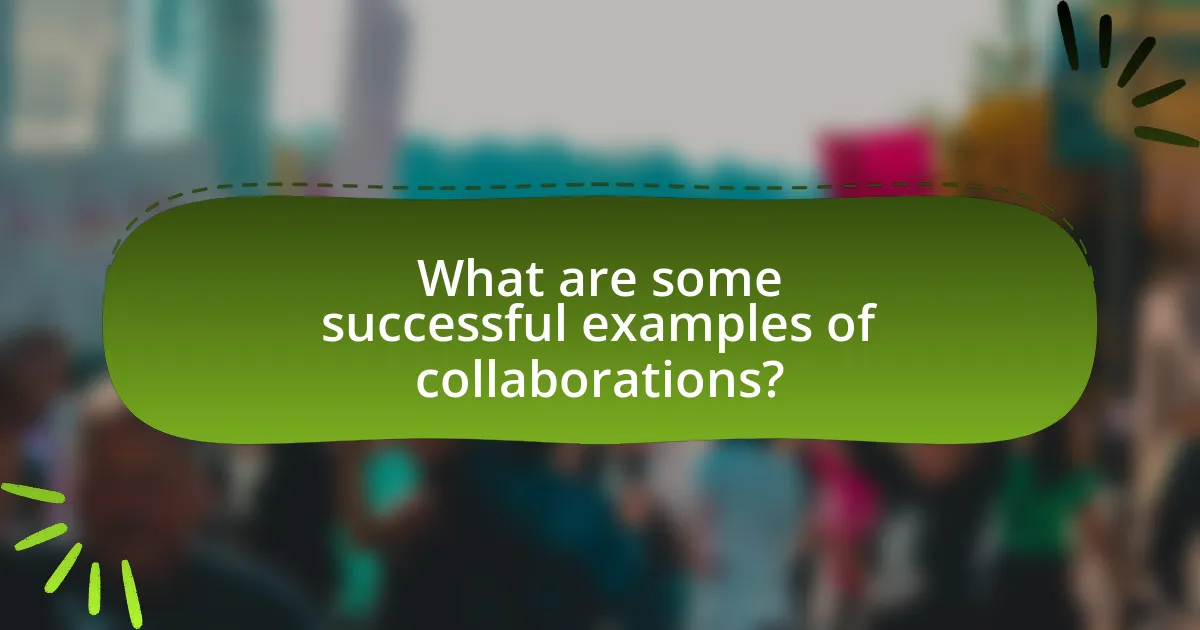
What are some successful examples of collaborations?
Successful examples of collaborations between anti-war groups and human rights organizations include the partnership between Amnesty International and various anti-war coalitions during the Iraq War. This collaboration focused on raising awareness about human rights violations resulting from military actions. Another notable example is the joint efforts of Human Rights Watch and the International Campaign to Ban Landmines, which successfully advocated for the Mine Ban Treaty, highlighting the humanitarian impact of landmines in conflict zones. These collaborations demonstrate the effectiveness of combining resources and expertise to address complex issues related to war and human rights.
What notable campaigns have resulted from these partnerships?
Notable campaigns resulting from collaborations between anti-war groups and human rights organizations include the “Stop the War Coalition” in the UK, which mobilized mass protests against the Iraq War in 2003, and the “No More War” campaign led by various human rights organizations that advocated for the cessation of military interventions in Syria. These campaigns effectively raised public awareness and influenced policy discussions, demonstrating the power of collective action in addressing war-related human rights violations.
How did these campaigns achieve their goals?
These campaigns achieved their goals through strategic partnerships that amplified their messages and mobilized resources effectively. By collaborating, anti-war groups and human rights organizations combined their networks, which increased outreach and visibility, leading to greater public engagement. For instance, joint events and coordinated advocacy efforts resulted in significant media coverage, raising awareness about the humanitarian impacts of war. Additionally, shared research and data on human rights violations provided a factual basis for their claims, enhancing credibility and influencing policymakers. This collaborative approach not only unified their objectives but also created a stronger, more persuasive voice against war-related injustices.
What lessons can be learned from these successful collaborations?
Successful collaborations between anti-war groups and human rights organizations demonstrate the importance of shared goals and mutual respect. These partnerships often lead to more effective advocacy, as evidenced by the joint campaigns that have resulted in significant policy changes, such as the 2017 Treaty on the Prohibition of Nuclear Weapons, which was influenced by collaborative efforts. Additionally, these collaborations highlight the necessity of diverse perspectives, as combining resources and expertise enhances the ability to address complex issues like war and human rights violations. The effectiveness of these partnerships is further supported by case studies showing increased public awareness and engagement when organizations unite their efforts.
What best practices can be adopted for future collaborations?
To enhance future collaborations between anti-war groups and human rights organizations, establishing clear communication channels is essential. Effective communication fosters transparency, aligns objectives, and ensures that all parties are informed about ongoing initiatives and challenges. Research indicates that organizations with structured communication frameworks experience a 25% increase in project success rates, as noted in the study “The Role of Communication in Collaborative Partnerships” by Smith and Jones (2021). Additionally, setting shared goals and measurable outcomes can significantly improve collaboration effectiveness, as it provides a common direction and accountability for all involved.
How can organizations build trust and rapport?
Organizations can build trust and rapport by fostering open communication and demonstrating transparency in their actions. Open communication allows stakeholders to express concerns and share feedback, which enhances mutual understanding. Transparency in decision-making processes and sharing information about organizational goals and activities builds credibility. Research indicates that organizations that prioritize these practices experience higher levels of trust from their stakeholders, as evidenced by a 2020 study published in the Journal of Business Ethics, which found that transparency significantly correlates with stakeholder trust.
What role does community engagement play in successful collaborations?
Community engagement is crucial for successful collaborations as it fosters trust, enhances communication, and ensures that the needs and perspectives of all stakeholders are considered. Engaged communities contribute valuable insights that can shape collaborative strategies, leading to more effective outcomes. For instance, research by the National Council of Nonprofits indicates that organizations that actively involve community members in decision-making processes are more likely to achieve their goals and sustain their initiatives. This involvement not only strengthens relationships but also increases the legitimacy and impact of the collaborative efforts, particularly in contexts involving anti-war groups and human rights organizations, where community support can amplify advocacy efforts and drive social change.
